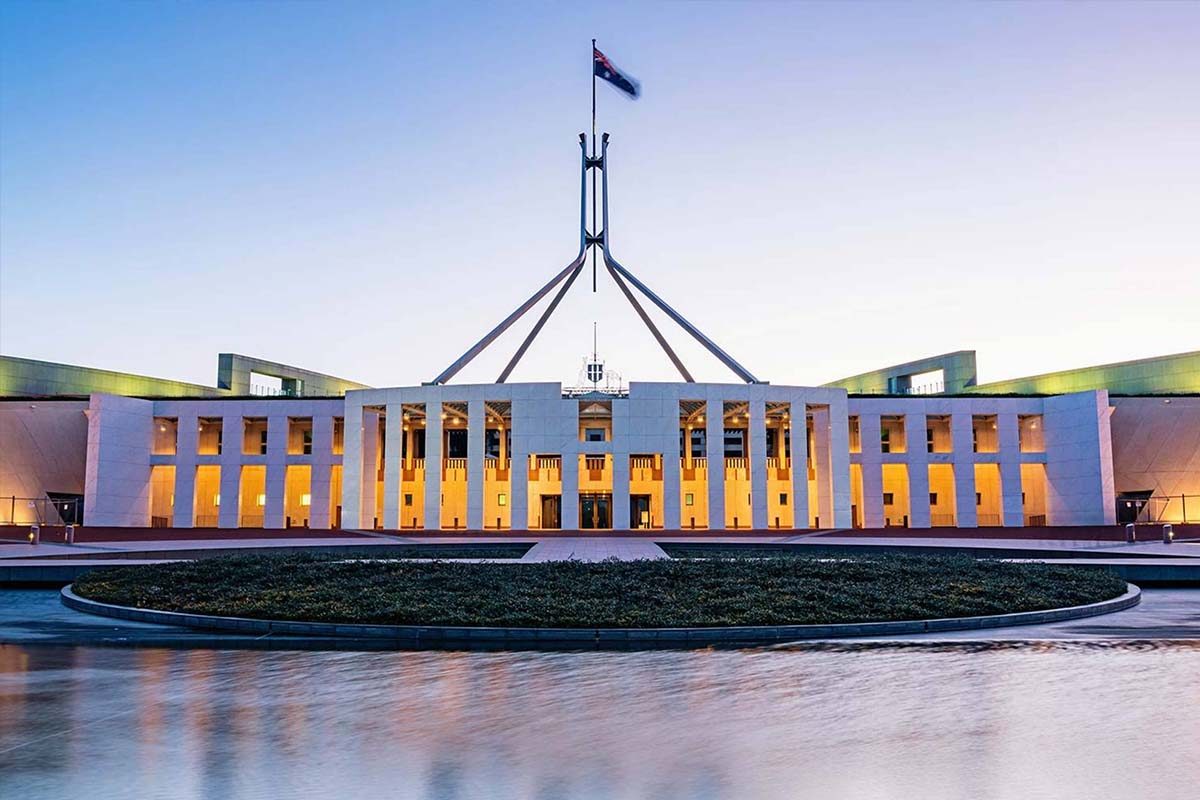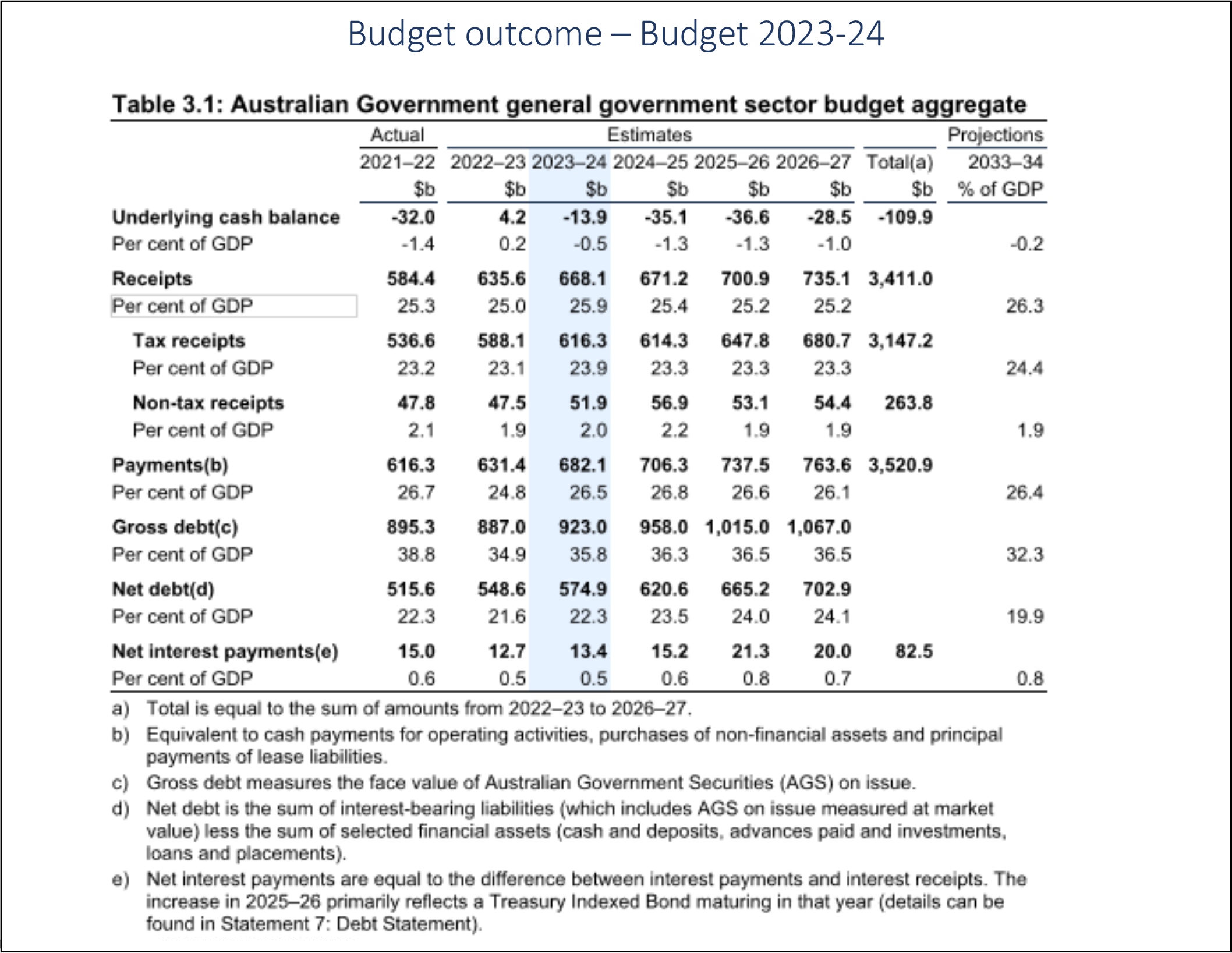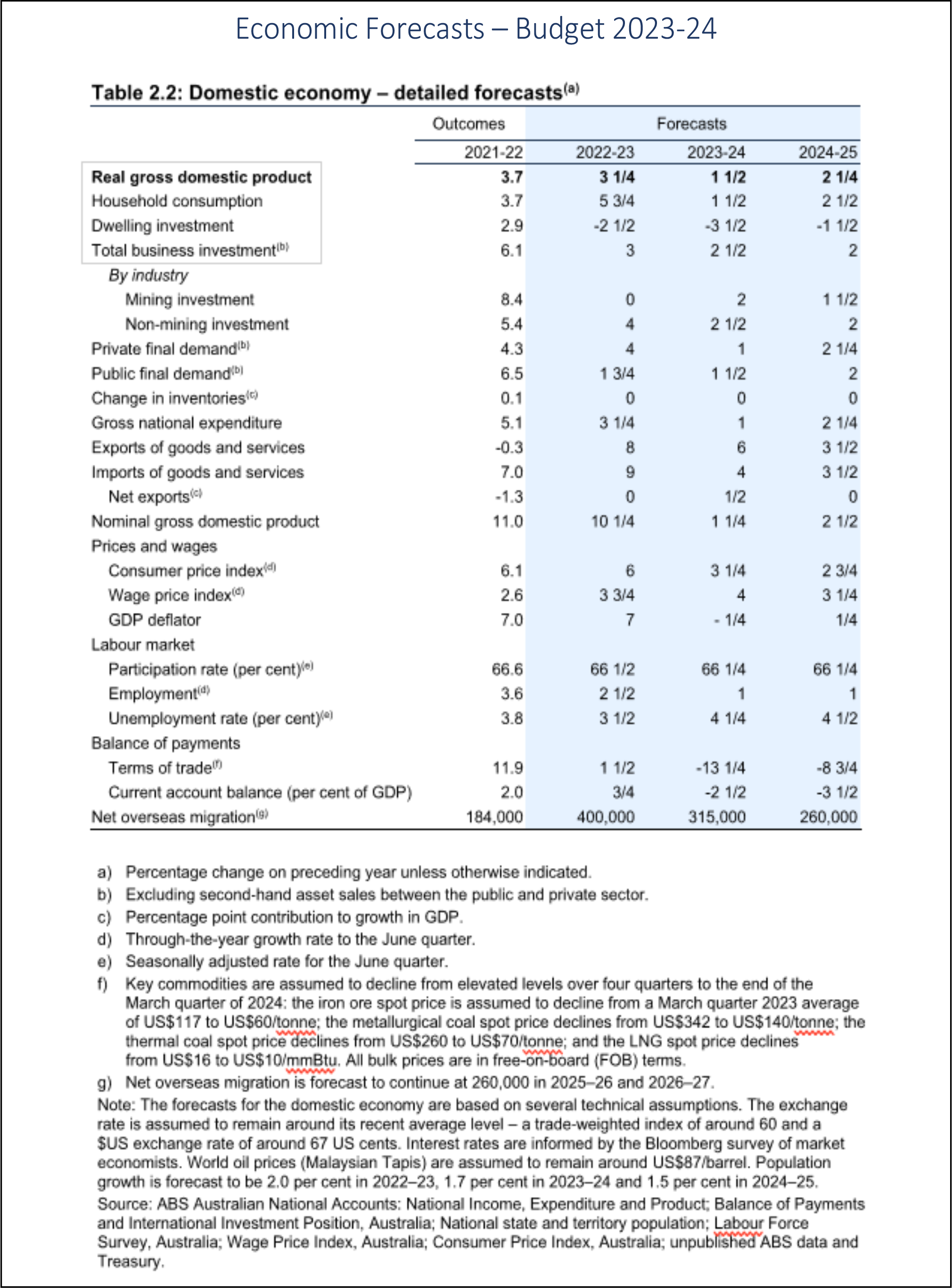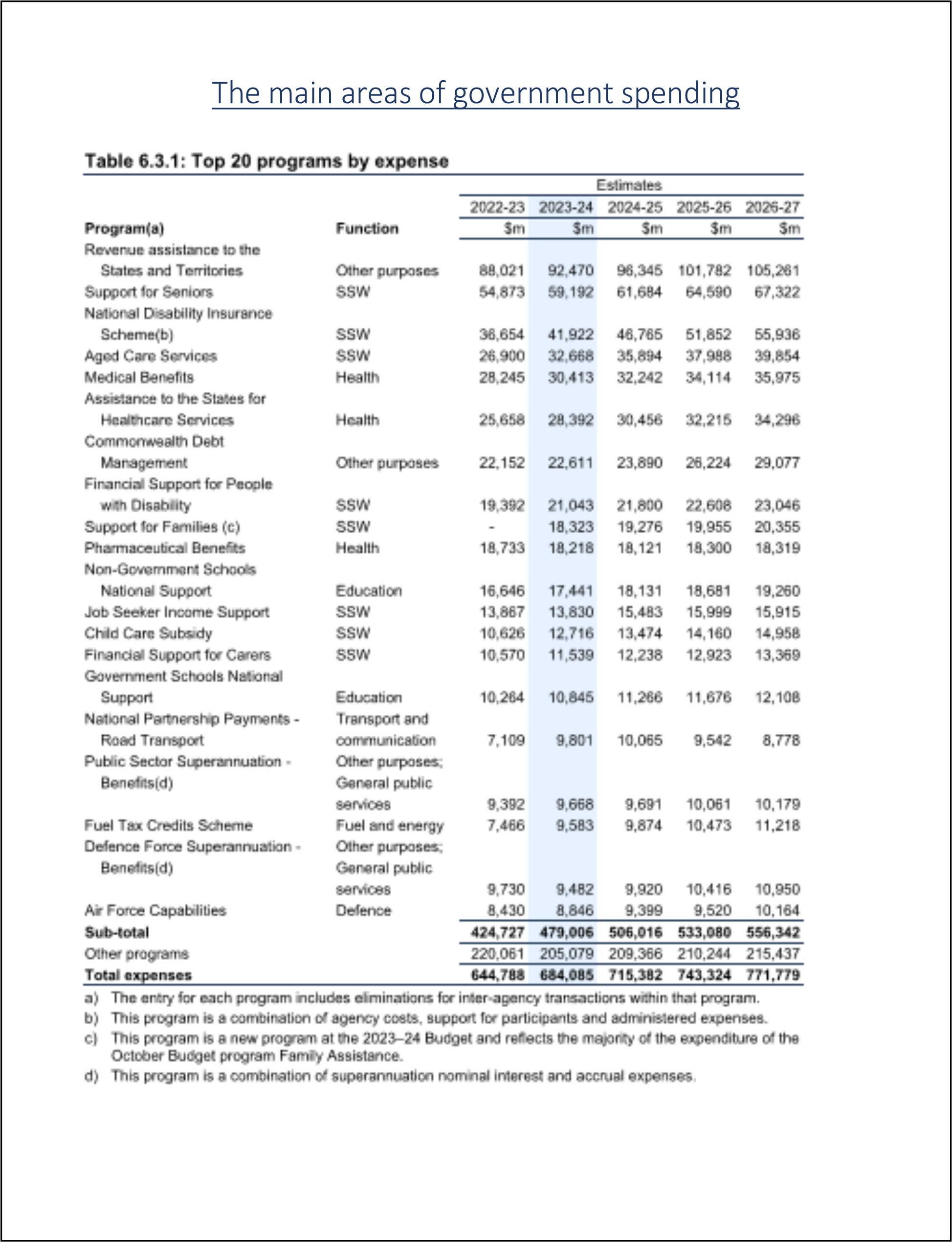
2023-2024 Parliament Federal Budget Report
Budget URLs
Links to all Budget documents
All Budget 2023 documents referred to references for individual items can be found at the following official Budget 2023-24 URL: Budget 2023-24.
Key messages
The Budget’s key initiatives had been largely foreshadowed by the Government – in actual announcements rather than customary Budget leaks – ahead of the Budget.
This included cost-of-living measures, of which the most substantial, a Federal Government $1.5 billion contribution to energy price relief, to be matched by state governments, had been announced in last October’s Budget.
The 2023-24 Budget served mainly to flesh out the details of the changes announced ahead of the Budget.
Of these perhaps the most significant was a $40 a fortnight increase in the base rate for JobSeeker, Austudy and Youth Allowance and dropping the minimum age for which older people qualify for a higher JobSeeker rate, from 60 to 55 years. The Government said the changes would benefit 1.1 million people.
In his Budget Speech Treasurer Jim Chalmers said, “In all our decisions, we seek to strike a considered, methodical balance. Between spending restraint to keep the pressure off inflation, while doing what we can to help people struggling to make ends meet.
“Making sure vital services like Medicare and the National Disability Insurance Scheme are secure, reliable and sustainable.
“And dealing with immediate, near-term challenges – while investing in our long-term national success – seeing our people through the hard times – and setting our country up for a better future.”
In the Speech he also said, “Our economic growth is expected to slow from 3 ¼ per cent in 2022–23 to 1 ½ per cent the year after, before recovering to 2 ¼ per cent in the next. Despite this, our economy will continue to create jobs and unemployment is expected to remain low by historical standards – 4 ¼ per cent in 2023–24, 4 ½ the year after.”
He said that “In this environment, inflation remains our primary economic challenge – It drives rate rises; it erodes real wages – Which is why this Budget is carefully calibrated to alleviate inflationary pressures, not add to them.
“Our policies to ease the pressure on households will take ¾ of a percentage point off inflation in 2023–24 – Which is expected to fall from 6 per cent this year to 3 ¼ per cent next year – Returning to the RBA’s target band in 2024–25.”
In his Speech the Treasurer also said, “We are now forecasting a small surplus in 2022–23 – which would be the first in 15 years. We expect that to be followed by a deficit of $13.9 billion in 2023–24. And, lower deficits across the forward years compared to recent Budgets – Leading to a $125.9 billion improvement over 5 years – And a much lower public debt burden.”
In the ‘Budget Glossy – Stronger Foundations for a better future’ the Government said, “This Budget addresses the immediate challenges Australians are facing, better shares the opportunities in our society and across the country and lays the foundations for a stronger and more secure economy. It provides responsible and targeted cost-of-living relief for those that need it most, invests in key drivers of sustainable growth and sustainably funds the services Australians rely on.
“It does this while strengthening our fiscal position with a budget surplus forecast in 2022-23 and lower deficits and debt across each of the forward years.
“This Budget builds stronger foundations for a better future by:
- delivering cost-of-living relief
- strengthening Medicare
- investing in a stronger and more secure economy
- broadening opportunity
- strengthening the Budget and funding our priorities
“This Budget strikes the right balance between dealing with immediate challenges and setting Australia up for the future.”
Budget outcome
The Budget Papers say the underlying cash balance is estimated to be in surplus by $4.2 billion (0.2 per cent of GDP) in 2022–23, the first surplus since 2007–08. This is an improvement of $41.1 billion compared to the October Budget and $82.1 billion since the Pre-election Economic and Fiscal Outlook.
Since October, tax receipts have been revised up by $67.2 billion across 2022–23 and 2023–24, underpinned by a strong labour market and elevated commodity prices. Strength in tax receipts is expected to moderate from 2024–25 as commodity prices are assumed to return to long-run levels and the conditions in the labour market ease. Overall, tax upgrades (excluding GST and policy decisions) have improved the underlying cash balance by $114.2 billion over 5 years from 2022–23 to 2026–27.
In his Speech the Treasurer also said, “We are now forecasting a small surplus in 2022–23 – which would be the first in 15 years. We expect that to be followed by a deficit of $13.9 billion in 2023–24. And, lower deficits across the forward years compared to recent Budgets – Leading to a $125.9 billion improvement over 5 years – And a much lower public debt burden.”
The Treasurer said, “We are returning 87 per cent of the tax upgrades over the past two Budgets and 82 per cent in this Budget. This Budget also identifies a further $17.8 billion in spending reprioritisations and restricts average annual real spending growth to just 0.6 per cent over the 5 years to 2026–27.
“Our decisions mean the underlying cash balance has improved by $125.9 billion over the 5 years to 2026–27, the biggest fiscal improvement on record. A budget surplus is forecast in 2022–23, a dramatic and unprecedented turnaround from the $77.9 billion deficit we inherited.
Economic growth
The Budget Papers says that while the Australian economy “is expected to outperform all major advanced economies, global and domestic headwinds will be a drag on activity in 2023–24. High inflation and rising interest rates are squeezing households, and these cost-of-living pressures along with weaker global growth will contribute to real GDP growth slowing to 1½ per cent in 2023– 24.
“Real GDP growth is expected to pick up to 2¼ per cent in 2024–25 with continued positive real wages growth and a recovery in household disposable income bolstering household spending. Nominal GDP is forecast to grow strongly by 10¼ per cent in 2022–23.
Inflation
The Budget Papers say “Inflation has peaked and begun to moderate. The factors that caused the current inflationary period are beginning to ease and inflation is expected to return to target in 2024–25. The Government’s measures to deliver cost-of-living relief will directly reduce the CPI in 2023–24, and are not expected to add to broader inflationary pressures in the economy. These measures are expected to reduce inflation by ¾ of a percentage point in 2023–24.”
The Budget Papers also say, “Inflation peaked at the end of 2022 and is now moderating. Supply constraints and the impact of Russia’s invasion of Ukraine have begun to subside and the Government’s Energy Price Relief Plan is expected to further reduce inflation in 2023–24. This should see inflation return to the RBA’s target band in 2024–25, although cost-of-living pressures will remain a near term weight on households.”
Employment and unemployment
The unemployment rate is projected to remain low by historical standards, but will rise modestly from 3½ per cent at present to 4¼ per cent by the June quarter of 2024 and 4½ per cent by the June quarter of 2025.
The tight labour market is expected to gradually soften in response to slowing demand. Employment growth will be supported by stronger migration, with a projected increase of 1 per cent in 2023–24. This is ¼ of a percentage point stronger than the October Budget.
The labour force participation rate is expected to fall slightly to 66¼ per cent in the June quarter of 2025, but remain at high levels. The Budget Papers say, “The strength of recent labour market outcomes is flowing through to wages, with growth projected to reach 4 per cent in 2023–24, its fastest pace since 2009. The Fair Work Commission’s forthcoming Minimum Wage Determination and the Aged Care Work Value Case are also assumed to contribute strongly to wages growth in the near term.”
Wages
Wages growth is forecast to pick up to 4 per cent in 2023–24, its fastest pace since 2009, supported by the Government’s actions to boost wages for lower paid employees. Wages are forecast to grow by 3¼ per cent in 2024–25.
Household consumption
Household consumption growth is expected to slow from 5¾ per cent in 2022–23 to 1½ per cent in 2023–24.
Investment
The Budget Papers say that business Investment is expected to grow by 3 per cent in 2022–23. “As overall demand in the domestic and global economy softens, momentum is expected to ease in 2023–24 and 2024–25, growing by 2½ per cent and 2 per cent, respectively. Non-mining investment is expected to be the main driver of growth in business investment over the coming years, increasing by 4 per cent in 2022–23, 2½ per cent in 2023–24 and 2 per cent in 2024–25.
Housing investment is expected to contract by 3½ per cent in 2023–24 as a result of higher interest rates and higher housing prices. The downturn in housing activity is expected to extend into 2024–25, with a further 1½ per cent decline anticipated, before recovering strongly over 2025 and onwards.
The Budget provides some additional information – but not a full state by state breakdown of the previously announced Federal Government’s $1.5 billion package to hedlp households and small businesses with power bills. The Budget says that from July 2023, the plan will deliver up to $500 in electricity bill relief for eligible households and up to $650 for eligible small businesses. It will provide energy bill relief to around 5 million households and 1 million small businesses.
Other cost-of-living measures include:
- Helping 170,000 households save on energy bills by financing energy saving home upgrades
- Reducing out-of-pocket health costs by tripling the bulk billing incentive to GPs
- More bulk billing Urgent Care Clinics
- Cutting the cost of medicine by up to half for at least 6 million Australians
- Doubling the regional pharmacy maintenance allowance
- Supporting 57,000 single parents by expanding eligibility for the Single Parenting Payment
- Increasing the base rate of JobSeeker, Austudy and Youth Allowance
- Lowering the age threshold for higher JobSeeker payment for older beneficies from 60 to 55 years
- Increasing Commonwealth Rent Assistance for 1.1 million households
- Tax breaks to encourage more investment in build-to-rent projects
- Funding a 15 per cent pay rise for aged care workers
- Supporting a pay rise for low-paid workers
Tax changes
Petroleum Resources Rent Tax
Offshore gas producers will have their tax deductions capped and face tougher tax compliance measures, estimated by Treasury to raise $2.4 billion over four years.
Stage 3 tax cuts
As expected, no changes were announced to the stage three personal income tax cuts. Labor has been under pressure to wind back the legislated cuts, set to cost more than $20 billion a year from July 1 2024.
JobSeeker, Austudy and Youth Allowances
The Budget increases the base rate for JobSeeker, Austudy and Youth Allowance by $40 per fortnight.
The Budget also lowers the eligibility age threshold for a higher JobSeeker rate for older people on JobSeeker from 60 to 55 years. Around 52,000 eligible recipients will receive an increase in their base rate of payment of $92.10 per fortnight. Payments will also continue to be automatically indexed for inflation, the Budget Papers said.
Housing
Rent assistance
The Budget increased the maximum rate of Commonwealth Rent Assistance by 15 per cent. The increase will cost the Budget $2.7 billion over 5 years, the largest increase to Commonwealth Rent Assistance in over 3 decades. Around 1.1 million households receive Commonwealth Rent Assistance.
Build-to-rent incentives
The Budget includes new incentives to encourage buid to rent projects by:
- reducing the withholding tax rate for eligible fund payments from managed investment trusts attributed to newly constructed build-to-rent developments from 30 to 15 per cent
- increasing the capital works tax deduction (depreciation) rate from 2.5 per cent to 4 per cent per year, increasing the after tax returns for newly constructed build-to-rent developments
The Government said “industry estimates this could unlock 150,000 rental properties over 10 years, boosting the supply of high-quality, long-term rentals in the Australian market.”
Investment in social and affordable housing
The Government will increase the National Housing Finance and Investment Corporation’s liability cap by $2 billion to a total of $7.5 billion, supporting more lending to community housing providers for social and affordable housing projects.
Home Guarantee Scheme
The eligibility criteria of the Home Guarantee Scheme will be expanded. Eligibility for the First Home Guarantee and Regional First Home Guarantee will be expanded to any 2 eligible borrowers beyond married and de facto couples, and non-first home buyers who have not owned a property in Australia in the preceding 10 years. Australian Permanent Residents, in addition to Australian citizens, will be eligible for the Home Guarantee Scheme.
Aged care
Aged Care Minister Anika Wells said on 4 May, the Budget would include $11.3 billion over 4 years to fund the outcome of the Fair Work Commission’s 15 per cent pay rise for aged care workers from 1 July 2023.
The cost of delivering aged care will rise by 23 per cent, increasing from $24.8 billion to an estimated $29.6 billion.
The $11.3 billion cost of meeting the 15 per cent wage increase will deliver weekly pay rises ranging from $196.08, or more than $10,000 a year, for a registered nurse, to around $150 a week for cooks, care workers, activity officers and other workers.
Prime Minister Anthony Albanese went to the 2022 election pledging to support a union application for a 25 per cent pay rise for the sector’s 300,000 workers, warning that without a generous increase, the sector would struggle to retain staff, let alone recruit more. He also promised a registered nurse working 24/7 in every nursing home by July 1, this year, but this deadline will not be met.
In February, the Fair Work Commission granted an “interim” wage increase of 15 per cent based on the workers’ increased work value and qualifications. The Government welcomed the decision but urged the increase be paid in two instalments – 10 per cent this year and 5 per cent next year – to relieve pressure on the budget. The Commission rejected this.
Ms Wells said registered nurses, enrolled nurses, assistants in nursing, personal care workers, head chefs and cooks, recreational activities officers (lifestyle workers) and home care workers will see an historic increase to their award wages.
Single parent payments
The Budget restores the Single Parenting Payment to eligible single parents until their youngest child turns 14 (currently up to 8 years old). The age threshold was reduced to 8 years by the Gillard Government after previously being reduced from 16 to 12 years by the Howard Government. Single Parents who had not been eligible for the Single Parents Payment had previously been moved to the JobSeeker Payment. The current base rate of Single Parenting Payment is $922.10 per fortnight, compared to the JobSeeker Payment base rate of $745.20 per fortnight.
Around 57,000 single principal carers, including 52,000 women, and around 110,000 children will benefit from the higher rate, the Budget said.
Single parents eligible for the Single Parenting Payment will also benefit from more generous earning arrangements compared to JobSeeker. Eligible single parents with one child will be able to earn an extra $569.10 per fortnight, plus an extra $24.60 per additional child, before their payment stops.
The changes take effect on 1 September. The change will cost the Budget $1.9 billion over 5 years, with 91 per cent of recipients women.
Health
Tripling bulk billing incentives
The Budget provides $3.5 billion over 5 years to increase the bulkk billing incentive for GPs. The bulk billing incentive will be tripled for the most common consultations for children under the age of 16, pensioners and other Commonwealth concession card holders. Included are face-to-face, telehealth and videoconference consultations.
The Budget said the bulk billing incentive will continue to be higher for patients in regional and rural areas.
New PBS listings
The Budget provides $2.2 billion over 5 years for new and amended listings to the PBS, including treatment for cystic fibrosis. A further $449.4 million is provided for newand amended listings to the National Immunisation Program.
Welfare
The government said it will scrap the ParentsNext program, ending compulsory mutual obligations for about 100,000 parents who were placed in the program. The program was costed at $484 million over the forward estimates but won’t be scrapped entirely until the existing contracts end in the next financial year. Some mutual obligation requirements will remain.
Tax collections
Since October, tax receipts have been revised up by $67.2 billion across 2022–23 and 2023–24, as a result of the stronger labour market and higher commodity prices. The increase in tax receipts is expected to moderate from 2024–25 as commodity prices, with the Budget assuming commodity prices will return to long-run levels and the labour market weaken. Overall, tax upgrades (excluding GST and policy decisions) have improved the underlying cash balance by $114.2 billion over 5 years from 2022–23 to 2026–27.
Excluding GST and policy decisions, tax receipts have been revised up by $41.2 billion in 2023–24 and $114.2 billion over the 5 years from 2022–23 to 2026–27. The Budget says the Government is returning most of the improvement in tax receipts to the budget – ie, being used to reduce the deficit. 87 per cent of the tax upgrades in the past 2 Budgets are being returned (82 per cent this Budget).
Policy decisions since the October Budget are expected to increase tax receipts by $1.3 billion in 2023–24 and $19.1 billion over the 5 years from 2022–23 to 2026–27. These include:
- GST compliance program—four-year extension
- Tobacco Excise
- Increased tax rate on superannuation balances over $3 million
- Petroleum Resource Rent Tax changes
- Small Business Support – $20,000 instant asset write-off and Small Business Support
- Small Business Energy Incentive
- Build-To-Rent accelerated tax deductions
- Reduced managed investment trust withholding tax rate
Tax receipts outlook
Relative to the October Budget, tax receipts are forecast to be $42.0 billion (or 7.3 per cent) higher in 2023–24, and $134.8 billion (or 4.5 per cent) higher over the 5 years from 2022–23 to 2026–27. This upgrade reflects a stronger outlook for personal income tax and company tax. Personal income taxes have been revised up by $15.0 billion in 2023–24 and $74.1 billion over the 5 years from 2022–23 to 2026–27.
Small business
Treasurer Jim Chalmers confirmed ahead of the Budget that about 1 million small businesses would get extra assistance with electricity bills in the budget.
The Small Business Energy Incentive will give businesses with a turnover of less than $50 million a 20 per cent tax deduction for eligible assets supporting electrification and more efficient use of energy, from 1 July 2023 until 30 June 2024. Up to $100,000 of total expenditure will be eligible for the incentive, with the maximum bonus tax deduction being $20,000 per business.
This is in addition to $62.6 million towards energy efficiency grants for small and medium enterprises in the October Budget.
Small business instant asset write-off
The measure provides $290 million in cash flow support for small businesses with a $20,000 instant asset write-off.
Businesses will also receive cashflow relief from the halving the increase in their quarterly tax instalments for GST and income tax in 2023–24. Instalments will increase by 6 per cent instead of 12 per cent.
Industry Growth Program
A new $392.4 million Industry Growth Program will help support small to medium-sized businesses and startups develop new products and services to grow their operations.
Appendix: Tables



Book Free Consultation
Book your free 15 or 30-minute phone consultation at a time that suits you.
Recent Post
- Revised stage 3 tax cuts confirmed for 1 July 14/03/2024
- How to take advantage of the 1 July super cap increase 14/03/2024
- The ATO Debt Dilemma 14/03/2024
- The Fringe Benefit Tax traps 14/03/2024
- Is your business eligible for concessions? 29/02/2024
About RaAdvisory
RA Advisory provides accounting for small to medium businesses while also servicing your individual tax and financial needs.
5.0
(Based on Google Reviews )




